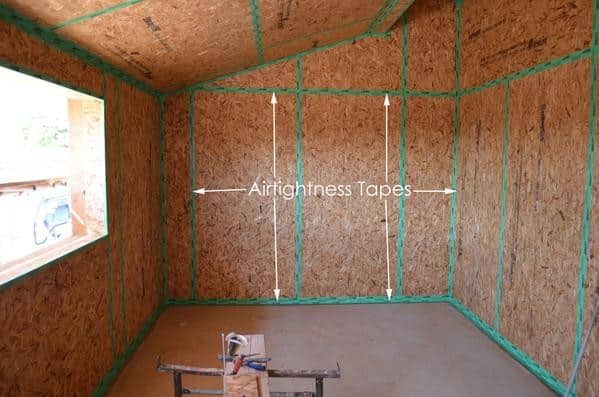SPECIFICATION GENERATOR
Find out which low impact materials are right for your building project.
Why airtightness is important when building a sustainable home…
Find out more about our approach to this building scenario.
Every day we breathe around 11,000 litres of air, which comes out very moist. We shower, producing lots more moist air (at least the same amount again), we cook and we boil kettles for our tea. In short we produce huge amounts of warm, moist air which needs to be removed to keep the indoor environment healthy and free from mould. The only effective way to achieve this is by incorporating a mechanical ventilation system (unless you live outdoors permanently), guaranteeing a continuous supply of fresh air and removal of stale, moist air.
Indoor air quality is an important consideration but equally as important is how the moist air that we produce affects the structure of the buildings in which we live. In the winter, this moist air leaks in to the cold building fabric and condenses, causing timber to rot, metal to corrode and mould to grow. As we insulate more, the colder the outer layers of our buildings become and the more they are prone to condense any air leaking from inside.
This means that high levels of insulation, very good airtightness and good ventilation must go hand in hand to produce low energy sustainable homes.
Why should I pay attention to the airtightness of my home?

In the average UK home around 15% of the total heat produced is lost through drafts. This represents an enormous amount of heat but for a well insulated home these losses represent a much larger portion of the heat lost. Airtightness is a critical aspect to consider when building low energy buildings as the effectiveness of insulation is massively reduced by poor airtightness.
The other consideration is that as buildings become better insulated any air leakage has more of a chance of condensing within the walls during the winter and causing issues with moisture. This can affect both timber framed buildings and masonry buildings alike as it not only reduces the effectiveness of the insulation but it can also cause timber to decay.
A good target to aim for would be a blower door test result of around 1 air change per hour or 1 cubic metre per square meter of wall area, depending on which way you’re measuring it. If you’re aiming for Passivhaus standard this will need to be 0.6 air changes per hour or less.
If you’re worried the house might get stuffy at this level of airtightness, don’t. Air leakage from draughts has been shown many times not to improve air quality and you always have the option to simply open the window!!
How do I get my house airtight?

Good design, careful construction and lots of air tightness tape is the simple answer.
Good designs are ones in which you can clearly identify where the airtightness layer will be, how each one relates to the adjacent layer and also how it will work around any penetrations. These would be windows, doors, internal floors, beams, joists, etc. The simple rule of thumb is that you should be able to take a sectional drawing of the building at any point and follow the airtightness layer with a pencil all the way around the inside of the building without the pencil leaving the paper.
Careful construction takes a lot of planning when it comes to airtightness. Each new section of the building has to be made airtight (or able to be made airtight at a later date) as it goes up. In the case of timber frame this means taping joints in membranes or OSB before the next wall panel goes up and obscures any joints. For masonry it involves making sure mortar joints are well filled and if there are penetrations to the masonry they are well sealed around. Try and visualise how each and every junction will be built and how it will be made airtight.
This might sound like overkill but the energy saving from removing draughts is enormous.
Finally, sealing of all joints and junctions with the appropriate materials is critical. Airtightness layers can be made from OSB, airtightness membranes or from simple plaster but what ever is used it should be continuous (with no holes in it) and long lasting. Duct tape works really well for a few weeks but is likely to detach after that so the proper airtightness tapes are well worth using!!
What’s next?
If you want to find out more about how to effectively manage your sustainable building project, check out The Self-Build Series. This series of guides has been put together to you understand sustainable construction. We hope you find them useful!
